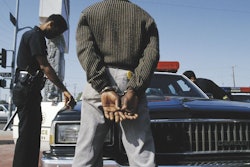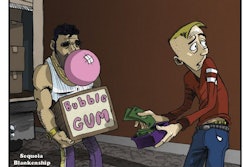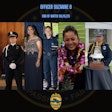The call comes through the 911 emergency line shortly before dawn.
“I need the police right away! It’s my husband. He beat me again, I’m bleeding, andC9” The loud crash that follows means the phone has fallen or been yanked away. But before the line disconnects, there’s the woman’s pleading cry:
“He’s got a gun!”
All available units are dispatched immediately. The four cars that arrive on the scene observe a man on the front porch who appears obviously drunk and not particularly worried to see the police.
After just a few words with the man, three units leave while the remaining officers enter the house for a cursory check. No arrest is made, although the cowering victim they meet inside has obviously been beaten. Within moments the police leave. The code they give the dispatcher is 1-David, which stands for: domestic violence assignment, no police service necessary.
So what’s wrong with this picture? It’s another example of what may be one of the best-kept secrets in law enforcement. Domestic violence within police families has always existed. It’s one of the original “don’t ask, don’t tell” problems that has been alternately ignored, unreported, or kept carefully hidden from the public eye by officers anxious to protect their fellow cops.
Retired Chicago Police Department Homicide Lt. Dennis Banahan believes it would be impossible to estimate the number of domestic homicides that occurred within police families during his 31-year career because of the unofficial protocol for handling such cases.
“Since the earliest days of law enforcement, domestic violence in police families was considered an officer’s personal business, one of those private realms into which departmental administrators chose not to involve themselves,” Banahan says. “Their attitude was that unless the problem affected an officer’s job performance, they’d prefer to ignore it. Whatever happened behind closed doors remained private. Since a large part of a cop’s M.O. is to maintain a game face, personal problems were considered just more of what we were expected to suck up and keep hidden.”
Some officers have now realized that such attitudes have been disastrous not just for the spouses and loved ones of abusing officers but also for the perpetrators and the public. “What wasn’t taken into consideration was that this policy creates a self-perpetuating problem. If our officers are victimized by job stress, the resulting physical abuse creates more victims, either at home or toward the public we serve,” says Banahan.
Code of Silence
Police officers have always prided themselves on their ability to keep secrets within the law enforcement family. That’s the case in some departments to this day, and it was almost a universal truth when Banahan came on the force.
And no incident was more likely to bring down the Blue Wall or trigger the Code of Silence than a cop who beat his wife. It was the kind of thing that cops didn’t discuss. Nor did agencies want to get involved.
“Our agencies offered nothing but after-the-fact damage control,” Banahan says. “That’s when the infamous “Code of Silence” came into play. The first officers arriving at the scene of any cop-involved domestic violence call were expected to be the primary spin doctors.”
The spin worked like this. Any witnesses beyond the victim and offender were removed from the scene. If the victim was still alive, she would be separated from the abuser. Then the responding officers would start to manipulate the victim.
“She’d be told that an arrest would serve no one’s best interests, and would absolutely jeopardize the officer’s job, thereby threatening the family’s security,” says Banahan. “That was a rationale I always found particularly offensive. In effect, that’s telling a bleeding victim, ‘Hey, sorry about the broken arm and that your nose will never be the same again, but drop a dime on this guy and you’ll all be in the welfare line tomorrow.’”
Rookie Training
There’s something heinous about a cop manipulating an abused spouse to keep a buddy out of trouble. And Banahan agrees.
“I know it sounds horrible,” he says. “But one of the first lessons police learn is to protect each other, and it’s that sense of loyalty that dictated our actions. As a rookie cop, I was told that my co-workers’ personal problems weren’t exposed, not in public and certainly not in a police report. In incidents of police domestic violence, it wasn’t simply a case of abuse and injury. It was also about protecting a brother cop’s career.”
Banahan recalls that when he was a rookie cop, other officers trained him in how to process police domestic violence cases. The most common method was failure to file an official report, followed by withholding information from the victims. “I’ve seen officers neglect to offer victims the option to sign complaints, or not give them the standard victim’s information rights sheets we normally distribute to other abuse victims,” he says.
According to Banahan, cops can easily use their knowledge of the law and the legal system to prevent abused spouses of fellow officers from swearing out complaints. “Some victims demand to swear out a peace bond, which in Illinois is called an ‘order of protection.’ So our officers might say, truthfully, that there’s no such thing as a peace bond in Illinois. What they don’t mention is the order of protection that can be issued by court order after a police report’s been filed,” he explains.
Savvier victims have a tendency to take their complaints to the department brass, but that often results in no justice and in no help for the family.
“When the victims took their complaints to a higher level of the Department’s administration, the stonewalling continued,” Banahan says. “Without a viable alternative plan in place, the brass had nothing to offer the victim and risked adverse media exposure [if they took any action].”
Whistling Past the Graveyard
Any homicide cop knows what happens when domestic violence continues unabated. They know because they get called to scene.
“When I became a homicide detective, that’s when I saw the results,” Banahan says. “Too many bricks in that Blue Wall of Silence triggered more domestic homicides and suicides than I care to think about.”
Banahan is not alone in being haunted by the deaths of abused police spouses and frustrated by his department’s failure to prevent them.
One cop, a 24-year veteran of the Los Angeles Police Department, still vividly remembers his first experience with a police-involved domestic homicide. In that case the officer locked his kids in the bedroom before beating and killing his wife, and then he shot himself.
“There was never any question of how it would be handled,” says the officer, who asked to remain anonymous. “As the new kid, I was schooled by my supervisors in ‘the police way’ of doing things. And there I was, a green kid struggling to handle all of this while my sergeant was telling me, ‘This is a police family, so we gotta take care of things. This was one of our own, and we owe him that.’”
The LAPD veteran says that not only did police cover up the evidence of domestic violence perpetrated by fellow cops, they never even discussed what caused one of their buddies to attack his wife.
“At that time, domestic violence by cops was one of those taboo topics we all knew about but never discussed. In a way, it was like whistling past the graveyard. Every night of policing is like running across a minefield. I’m sure we all believe we would never be abusers, but this job teaches us never to say ‘never.’ Any one of us might have been next. So we tiptoed around it, doing whatever we could to hide what’s obviously a critical problem. The press would call it misreporting or failing to report a crime. To us, it was just a matter of closing the ranks,” he says.
Sympathizing with Victims
Officers who respond to police-involved domestic violence calls face an emotional tug-of-war between protecting the abuser, a fellow cop, and sympathizing with the victim. Since the overwhelming majority of officers who abuse their loved ones are male and their victims women, it’s especially hard on female cops who respond to these calls.
“When every instinct is to rescue the victim, how do you justify why you’re not arresting her abuser?” asked a female officer from New York. “I’ve gone in on domestic violence calls knowing in advance that since a police officer was involved in the dispute, no action would be taken other than medical treatment.
“Our standard procedure was to separate all parties and convince the victim that a cooling-off period would be enough to restore the peace, which was a bogus bill of goods that nobody believed, least of all the battered victim. I’ve had bleeding, desperate women accuse me of protecting cops and then ask why, as a woman, I wasn’t willing to help them,” she says.
Tragic Cycle of Intimacy
Now that the dirty little secret of police domestic abuse is being dragged into the light of day by officers who are willing to talk about it, the next step is to find a way to stop it. But in order to prevent police domestic abuse, we first must discover what causes an officer to attack his or her loved ones.
According to Dr. Marvin Seigal, a clinical psychotherapist from Chicago, the factors that contribute to domestic violence are the same components that draw both victims and witnesses into what he describes as a “cycle of intimacy.” “On the most basic level, stress is created by situations that make us fearful of losing control,” Seigal explains. “Since police work involves stress levels that are off the charts, cops either learn to adapt or develop escape mechanisms meant to camouflage their anxiety, or fear of failure.”
Seigal believes the relentless stress of police work is often the root cause of officer-involved domestic violence. His theory goes that cops deal with the daily reality that any given incident might require them to take someone’s life, or risk losing their own, so they must remain in the moment at all times and that prevents some officers from finding a healthy release mechanism for their stress.
“In a career where there’s no break in the action, they don’t have time for self-analysis, much less problem resolution,” says Seigal. “So what begins as a few drinks after work or the random argument with a spouse can escalate into a serious problem, one the officer rationalizes by refusing to acknowledge responsibility.”
It’s the Job
According to Seigal, alcoholic officers and officers who abuse their loved ones have at least two things in common: They blame the job for their failings and they believe they can control their behavior.
“This is the argument he uses later, when the physical abuse begins and he draws his victim into the post-traumatic ‘cycle of intimacy,’” Seigal explains. “After every incidence of abuse, he swears he’ll never do it again. It was the job, not his own behavior that caused the problem.”
What Seigal calls the “post-traumatic cycle of intimacy” kicks in when the abuser plays on his history with the victim to convince her that he is sorry, it was the job, and that he’ll never hurt her again. And, of course, he will.
“By accepting this excuse, the victim also accepts the behavior and becomes the keeper of this painful secret they share,” Seigal says. “Since both parties want to believe the violence will end, the abuser and the abused strike an emotional pact to forgive and protect each other. Instead, it becomes an act of collusion that fosters increasingly violent behavior. By admitting his weakness, the abuser feels he’s earned the right to indulge it.”
Enablers in Blue
The cycle of intimacy concept can apply to any abusive relationship, civilian or police. But there’s another factor that’s typically only found in the relationships of police abusers and their victims: collusion by local law enforcement.
“By protecting him in the name of professional loyalty, his fellow cops have become enablers,” says Seigal. “Nobody wants to rat out a brother officer. But protecting what they perceive as a good cop with problems is actually supporting what’s become a ticking bomb. There are a lot of emotional issues here, and without appropriate professional intervention, the cycle will continue. We’ve got enough police-family homicide statistics to support the gravity of this problem. This is no longer a law-enforcement issue that can simply be swept under the rug.”
Intervention Program
Because more and more cops are willing to talk about police domestic violence, other dedicated officers can work to prevent it.
One such activist is former Florida major crimes detective Renae Griggs. After years of handling police domestic violence cases and serving as an advocate of incarcerated victims, she established the National Police Family Violence Prevention Program.
”In police domestic abuse cases, everyone is a victim,” says Griggs. “If there are no services, intervention, or treatment provided for our officers and their families, how can we expect any positive outcome? Their optimum mental and emotional health can only be realized by recognizing their problems and offering appropriate help and services.”
Griggs’ program is designed to provide officers who need it with the appropriate help and services to respond to their problems. Services include preventive and therapeutic care and an educational module designed to help officers recognize critical symptoms of stress and to identify dysfunctional coping behaviors.
“By initiating safe, victim-centered outreach and advocacy programs, we meet the needs of police families as well,” says Griggs. “A nonjudgmental therapeutic environment ensures all participating members the confidential care they deserve.”
The first critical step in making such a program work is reducing the old-school stigma of acknowledging the problem, and seeking treatment. And Griggs is well aware of it.
“In our job, admitting a personal weakness has always been tantamount to proclaiming yourself a member of the Wimp Squad. In the old days, real cops didn’t have problems. So why did so many of them develop drinking or drug problems or end up sucking their guns? The bottom line was, and continues to be, inappropriate coping mechanisms,” she says.
Griggs believes that the key to removing the stigma on officers seeking help is to gain the endorsement and participation of sponsoring police agencies. “In this way, treatment and education not only become more acceptable but are viewed as another facet of progressive law enforcement policy,” she says.
Griggs is actually helping her fellow officers by exposing police domestic violence issues. In contrast, all those cops who maintain a code of silence about police domestic abuse think they are helping, but all they are doing is making the situation worse.
“Our ultimate goal is to prevent abuse before it starts,” Griggs says. “Since we’re sworn to serve and protect, it’s our responsibility to protect each other as well. Police family violence is a public safety issue. Promoting safe and healthy police families serves society’s interests as well, since our citizens depend on the protection and services of a reliable police force. By teaching our departments how to best help their officers and their families, literally thousands of lives can be saved.”












